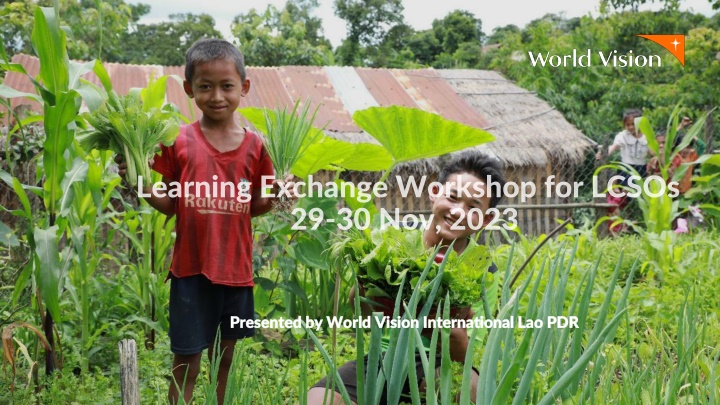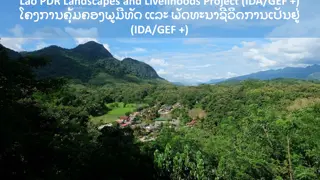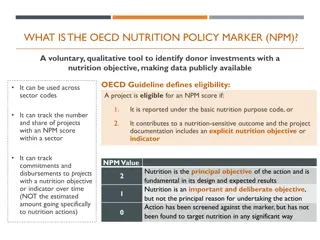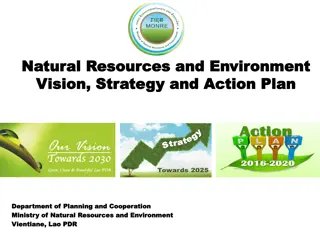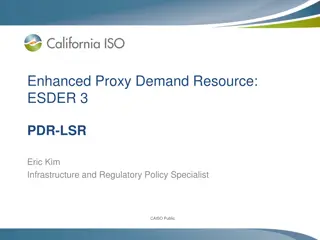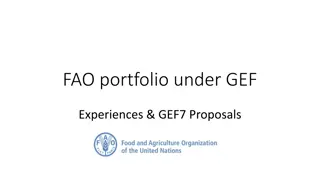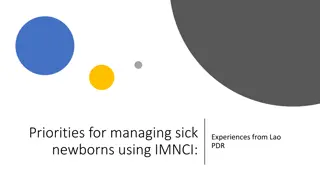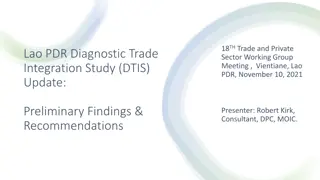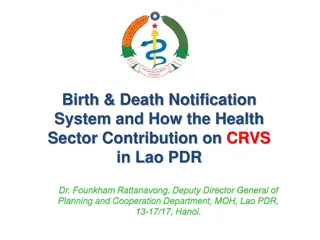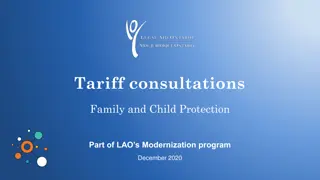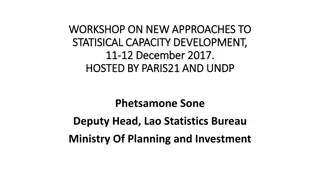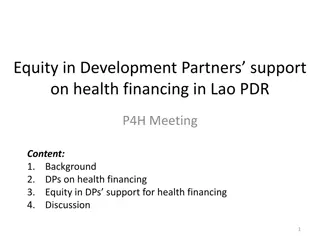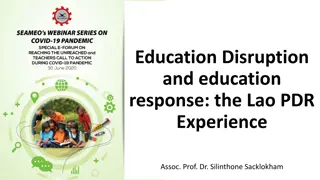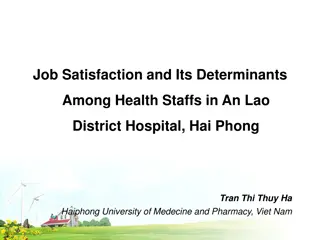Nutrition and Health Program Progress in Lao PDR
World Vision International is implementing a comprehensive nutrition and health program in multiple provinces of Lao PDR from 2020 to 2026. The program focuses on training healthcare staff, improving access to healthcare services, strengthening nutrition services, and promoting healthy practices for children under five and their caregivers. Major outcomes include increased access to healthcare services, improved nutrition practices, and enhanced household hygiene. Local partners are actively involved in supporting program implementation and management. The program targets various indicators to measure progress towards its goals, such as the number of children reached, caregivers' practices, and household sanitation improvements.
Download Presentation

Please find below an Image/Link to download the presentation.
The content on the website is provided AS IS for your information and personal use only. It may not be sold, licensed, or shared on other websites without obtaining consent from the author.If you encounter any issues during the download, it is possible that the publisher has removed the file from their server.
You are allowed to download the files provided on this website for personal or commercial use, subject to the condition that they are used lawfully. All files are the property of their respective owners.
The content on the website is provided AS IS for your information and personal use only. It may not be sold, licensed, or shared on other websites without obtaining consent from the author.
E N D
Presentation Transcript
Presented by World Vision International Lao PDR Presented by World Vision International Lao PDR
Area Program Louanphabang - 2 districts Phonexay(12) & PakOu(13)AP Khammouan- 4 districts AP Mahaxay(17), Gnommalath(13), Xaybouathong(25) & Xebangfai(14) Savannakhet - 1 district Nong(14) Grant Fund Saravane 1 district Samoui (15). Grant Fund Project period 5 province: 2022 - 2026 Laungphabang. 2022 - 2025 Khammoun 2022- 2024 Savannakhet 2020-2024 - Saravan
Main Activity: Train master-trainers on TTC model methodology and monitoring. Cooperate with PHD & DHO to conduct training/refresher training on ANC, PNC, IMNCI, MCH book, IYCF, IMAM, SAM to HC staffs. Conduct training on C-IMNCI, CIMAM, IYCF, ANC, PNC, NNC(EENC) , birth spacing and safe delivery for VHV. Support routine outreach activities (Grow Monitoring Promotion (GMP), Immunization including deworming and Vitamin A) Support DHO/HC to conduct special events on World Breastfeeding week/food cooking demonstrate at community level
Major Progress Outcome Output Indicator Total target 2023 1,906 Achieved % 2,488 130.54 Local partners are trained and supporting ttC implementation and management information system # of children 0-59 months reached by a trained VHV Improved access to health care services Strengthened nutrition and health services (IMNCI, IMAM, Vaccination) and counselling for HCs # of HC trained on CMAM protocol # and % of CU5 with diarrhea treated-ORS/Zinc referred and treated 96 41 42.71 168 106 63.10 Number and percent of children 0-23 months served by ttC VHV 1,672 1,955 116.93 Improved dietary and care practices of carers of CU5 Improved IYCF, maternal, Newborn and child care practices by caregivers # of children 0-59 months attending growth monitoring activities Number of ttC registered newborns aged 0-23 month whose births were attended by a skilled birth attendant 4,127 4,029 97.63 Caregivers & community leaders provide a healthy & nurturing environment for CU5 91 167 183.52 Number of active VHV for ttC/Home visit 150 141 94.00
Samoui Nutrition Action Project (SNAP) Midline Study Report(July 2023) Baseline 2020 Midline 2023 Target 2025 Objectives Indicator Remarks Children and their caregiver improve dietary and care practices % of caregivers that report doing a range of age-appropriate stimulating activities with their child U3 in the past three days) % Infants (0-5 months) who are fed exclusively with breast milk 1.6% 51.3% 40% . 18.8% 58.5% 48% % women reporting satisfaction with their time spent on rest and leisure time Proportion of households using a basic drinking water facility Proportion of households using a basic sanitation facility (improved sanitation facility) Proportion of households practicing open defecation N/A 84.4% 49% Households reduce incidence of selected water, sanitation and hygiene diseases/illnesses linked to undernutrition 54.6% 73.6% 80% 15.7% 30.5% 30% 77.3% 30.9% 56% Households have the knowledge and skills to practice improved safe water and hygiene Proportion of households with basic hand washing facilities (including soap) Prevalence of diarrhoea in children under 5 18.4% 39.4% 35% 41.1% 39.8% 20%
Samoui Nutrition Action Project (SNAP) Midline Study Report(July 2023) Cont- Baseline 2020 Midline 2023 Target 2025 Summary of objectives Indicator Remarks Parents and caregivers' practices support improved health, nutrition, hygiene and nurture Proportion of children under 5 with diarrhoea who received correct management of diarrhoea Proportion of parents or caregivers with appropriate hand-washing behaviour Proportion of children under 5 who receive regular growth monitoring Proportion of Pregnant and Lactating Women who received at least 4 antenatal and 2 postnatal visits . Proportion of parents or caregivers with the means to save money Proportion of households with adequate food frequency Proportion and number of parents and caregivers who 82.9% 91.6% 90% 10.8% 78.4% 30% CSO 4 - Children and their caregivers have improved access to timely and regular health and nutrition services 29.7% 93.3% 55% N/A 32% 85% CSO 5 - Children and their caregiver improve access to nutritious food all year round 5.4% 23.8% 20% 94.0% 74.3% 96% N/A 33.1% 55%
Community Health and Nutrition System Strengthening (CHNSS)
Geographical Coverage Project Location: Savannakhet: 4 districts, Phine, Xonnabuly, Nong, Xepone. Attapeu: 2 districts, Samakhixay, and Sanamxai. Mahaxay, Xaybouathong, Gnommalath Khammuane: 3 districts, 89 Health Centers
Main Activity: Train master trainer (PHD & DHO staff) on using the standard VHV toolkit and other WV methodology for the RMNCAH visits and monitoring Build VHVs list of the district and train VHVs on standard VHV toolkit for the RMNCH home visits. Support VHVs to conduct home visits, including as per VHV toolkit, the registration of pregnant woman, children 0-59 months and adolescents in target villages and appropriate referral system Cooperate with DHO/HC to conduct community sensitization on good nutrition and health special events (World Breastfeeding, cooking demonstration, toilet day, etc..) linked to health and nutrition community practices, including covid-19 messages. Provide MCH books or other IEC material as necessary for health center for strengthening referral with VHVs on MCHN. Conduct monitoring, mentoring and supportive supervision for VHVs in coordination with DHO & HC staffs
Main WASH activities under Integrated Health and Nutrition Train VWSMCs, LWU and VHVs on personal and environmental hygiene and safe water and sanitation management Community-wide WASH promotion events Train and support VWSMC members and VHVs to conduct CLTS Provide transportation support for HHs to access materials for latrines Construct water supply systems. Train VWSMCs on committee management and water infrastructure maintenance
Main WASH activities Under Education Train VEDC on operation and maintenance Built hand washing stations Build school latrine Build water system for school Hygiene education
WASH for ALL Capacity building WASH innovation Developing the WASH guideline Strengthening WASH relationship with other development partners Support the National Central for Environmental Hygiene and Water Supply to ensure the country ODF goal achievement as plan 2025 Support and strengthening Provincial and District Namsaats on the water quality testing mechanism
Challenge Caregivers missed out of outreach activity especially June and December due to seasonal harvesting. The malnutrition in CU5 may take time to reduce due to the increase of food insecurity in the community affecting by economic down turn and most communities changed to plant cassava. Infants in the six month and under age group, are still fed supplementary food such as cereals, milk powder or rice soup. It is a positive sign for mothers who received postnatal care visits, but the women will have postnatal care only when they feel sick. VHV have left their village to work in other provinces due to economic issues. Material for building toilet from supplier too high . CLTS activity is challenged in some target villages, because of financial or material aid and road condition for transportation. Staff turnover and transitioning of project team increased gaps and a shortage of staff to support the implementation of project activities in the communities.
Lesson learned Working in good coordination with government partners in both planning and implementing activities is the key to complete and achieve the project plan. In rainy season the team learnt how to make and adapt the activity plan which was appropriate to the situation. Working with ethnic groups is very challenge as language, culture, and beliefs. So combining different approaches to work with community is more effective. Ex. engaging elders and traditional leaders is more champion than heads of village. Involving communities in constructing water system(cooperation, compromise, or group participation leads to all participants benefiting) is the way to build relationships and to strengthen their engineering technical capacity and skills for promoting sustainability of project activities as the more to get communities engaged the more ownership is gained and the maintenance responsibility is high. Integrated Nutrition program is effective on improvements of child nutrition: Building Secure Livelihoods: Provide small animal, home garden, Integrated WASH. Saving group for Nutrition. Gender and women s labour-saving technologies
